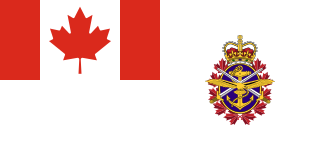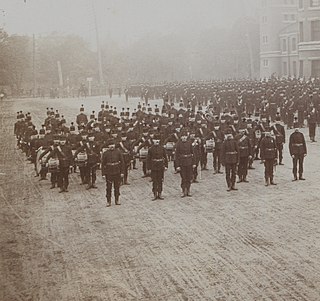Related Research Articles

A military band is a group of personnel that performs musical duties for military functions, usually for the armed forces. A typical military band consists mostly of wind and percussion instruments. The conductor of a band commonly bears the title of Bandmaster or Director of Music. Ottoman military bands are thought to be the oldest variety of military marching bands in the world, dating from the 13th century.

The Royal Canadian Regiment is an infantry regiment of the Canadian Army. The regiment consists of four battalions, three in the Regular Force and one in the primary reserve. The RCR is ranked 1st in the order of precedence amongst Canadian Army infantry regiments, but in a quirk of the rules of seniority, its 4th battalion is 9th.

Beating Retreat is a military ceremony dating to 17th-century England and was first used to recall nearby patrolling units to their castle.

United States military bands include musical ensembles maintained by the United States Army, United States Marine Corps, United States Navy, United States Air Force, and United States Coast Guard. More broadly, they can also include musical ensembles of other federal and state uniformed services, including the Public Health Service and NOAA Corps, the state defense forces, and the senior military colleges.
The Royal Canadian Corps of Signals is a component within the Canadian Armed Forces' Communications and Electronics Branch, consisting of all members of that personnel branch who wear army uniform. Prior to 1968 it was a combat support corps of the Canadian Army. The Royal Canadian Corps of Signals was re-instituted in 2013. It provides communication support and information systems for the Canadian Army.

The following is a list of the notable authorized marches for various organisations of the Canadian Armed Forces. The first march listed is the march most commonly performed for that organisation on parade; it is commonly referred to simply as that organisation's "march" or "march past". In addition, many organisations also have additional pieces for slow marches, marches for mounted parades, pipe marches, etc.; they are subsequently listed and footnoted as applicable.

A military tattoo is a performance of music or display of armed forces in general. The term comes from the early 17th-century Dutch phrase doe den tap toe, a signal sounded by drummers or trumpeters to instruct innkeepers near military garrisons to stop serving beer and for soldiers to return to their barracks and is unrelated to the Tahitian origins of an ink tattoo.

The Royal Canadian Army Service Corps (RCASC) was an administrative and transport corps of the Canadian Army. The Canadian Army Service Corps was established in the Non-Permanent Active Militia in 1901 and in the Permanent Active Militia in 1903. The Canadian Permanent Army Service Corps was redesignated The Royal Canadian Army Service Corps on 3 Nov 1919.

A Corps of Drums, also sometimes known as a Fife and Drum Corps, Fifes and Drums or simply Drums is a unit of several national armies. Drummers were originally established in European armies to act as signallers. The major historical distinction between a military band and a corps of drums, was that 'drummers' were not employed to play their instruments to entertain or delight, but rather they carried out a utilitarian battlefield role. This role was fulfilled by trumpeters or buglers in the cavalry and the artillery, who did not form into comparative formed bodies in the way that drummers did; therefore, an orthodox corps of drums will exist in the infantry arm.

The Royal Military College of Canada Bands is the official group of bands of the Royal Military College of Canada. The group is composed of four sections: the brass and reed, the pipes and drums, highland dancers, and choristers. Total band membership consists of 105 Officer Cadets from the college. Officer Cadets in the band practice three days a week in the morning on top of attending their individual full-time university programs.

The Royal Canadian Artillery Band is one of six Regular Force bands in the Canadian Armed Forces. Located at Canadian Forces Base Edmonton, the RCA Band provides music designed to support Canadian Forces operations, foster morale and esprit de corps, and promote Canada and the Canadian military nationally and abroad. The band operates mainly in western Canada and is de facto the representative band of the Canadian Army in the western provinces. All unit members are professional musicians in addition to being members of the military, which enables the band to adopt a variety of configurations to suit the musical needs of their audiences. Ensembles can range from jazz combos, rock bands, and chamber groups, through stage and show bands to full marching and concert bands.

A drum major in the military refers to someone who is the individual leading a military band or a field unit. It is an appointment, not a military rank. Military drum majors utilize a ceremonial mace for giving commands while marching. Many drum majors, particularly American- or British-influenced ones, wear a sash that can carry embroidered badges of their home unit and battle honors; a pair of ceremonial drum sticks are often attached.

Canadian military bands are a group of personnel in the Canadian Armed Forces (CAF) that performs musical duties for military functions. Military bands form a part of the Music Branch of the CAF, composed of six full-time professional Regular Force bands, 15 Regular Force voluntary bands, and 53 part-time reserve force bands. Bands of the Music Branch are often badged with the unit or Canadian Forces base insignia that they support.

A mounted band is a military or civilian musical ensemble composed of musician playing their instruments while being mounted on an animal. The instrumentation of these bands are limited, with the musician having to play his/her instrument, as well as steer the animal to the designated location. Most mounted bands, therefore, use instruments that can easily be held, such as bugles, horns, and Fanfare trumpets. Timpani and glockenspiels are also a common feature, usually located at the head of a band. Although a band that is mounted on any member of the families Equidae and Camelidae are considered to be a mounted band, horses are most commonly used, mostly being employed in military bands in Europe, North and South America, and some parts of Asia.

The Queen's Own Rifles of Canada Band & Bugles is a Canadian Forces military band serving as the regimental band for The Queen's Own Rifles of Canada. It is the oldest reserve band in uninterrupted service in Canada. Like the Band and Bugles of The Rifles, the QOR band has a drum and bugle section at the front ranks as a testament to the fact that those instruments were used to give orders on the battlefield during the conflicts of the 18th century. It is currently one of only several drum and bugle corps in the Canadian Armed Forces (CAF) in service.

The La Musique des Voltigeurs de Québec is the regimental band of the Les Voltigeurs de Québec. It is currently led by Captain François Dorion, a professional saxophonist and percussionist and a member of the regiment since 1991.
The Canadian Forces School of Music, CFSM was an educational institution that supported the music branch and all Canadian military bands in the Canadian Forces. It was created in 1954 in Esquimalt, British Columbia for musicians of the Royal Canadian Navy, with the school being the Canadian equivalent of the United States Armed Forces School of Music and the Royal Military School of Music. In 1961, the school was expanded and rebranded to include musicians from the Canadian Army and the Royal Canadian Air Force, and by the time of the Unification of the Canadian Armed Forces in February 1968, the school had officially been renamed to the CFSM. For its entire existence, the CFSM was located at CFB Borden in Ontario and offered enrolled students with a two-year educational program until it was disestablished in 1991. Enrollment varied with the requirement for musicians. The school also gave a one-year program to CF musicians with experience in the music branch who wish to serve in leadership positions in CF bands. Personnel of the Regular Force who wish to be qualified to as a pipe major have to attend a year long course at the CFSM in order be appointed to the post.

Princess Patricia's Canadian Light Infantry Band was the former brass and reed regimental band of the Princess Patricia's Canadian Light Infantry regiment of the Canadian Army. It was maintained by the regiment from 1919–1994 at CFB Calgary.

Navy bands in Canada are part of the Royal Canadian Navy's command structure and overseen by the Music Branch of the Canadian Forces and the Directorate of History and Heritage of the Department of National Defence.

Military bands in the United Kingdom are the musical units that serve for protocol and ceremonial duties as part of the British Armed Forces. They have been the basis and inspiration for many military bands in the former British Empire and the larger Commonwealth of Nations as well as musical organizations in other countries. Military musical units with British influence include United States military bands, the Japan Ground Self-Defense Force Music Corps and the Military Band of Athens. British military bands are controlled by the military music departments of the three services that compose the armed forces. These include the Royal Marines Band Service, the Royal Corps of Army Music, and the Royal Air Force Music Services. British style brass bands and carnival bands were then and are currently inspired by the British Armed Forces and its brass bands, especially of the Army's regular and reserve formations, as they follow a similar format as it relates to brass and percussion instruments.
References
- ↑ http://www.dcxmuseum.org/assets/15%2520-%2520Canadian%2520Military%2520Drum%2520and%2520Bugle%2520Corps.pdf&ved=2ahUKEwjJw9qw5tPmAhUFXM0KHdBUBu4QFjARegQIARAB&usg=AOvVaw2p9l-GZYX4FDm3EkT4dJFS%5B%5D
- ↑ Royal Military College of Canada - Review Yearbook (Kingston, Ontario Canada) - Class of 1964 pg. 118
- ↑ Kinder, K.W. (2014). This Awareness of Beauty: The Orchestral and Wind Band Music of Healey Willan. Wilfrid Laurier University Press. p. 207. ISBN 9781554589616 . Retrieved 22 December 2019.
- ↑ Wilson, K.A.; Fraser, I.S. (2017). The Making of a Tattoo: Canadian Armed Forces Tattoo 1967. FriesenPress. p. 115. ISBN 9781525514043 . Retrieved 22 December 2019.
- ↑ "The Minute Book". regimentalrogue.tripod.com. Retrieved 22 December 2019.
- ↑ Lownsbrough, J. (2012). The History of Canada Series: The Best Place To Be: Expo '67 And Its Time. Penguin Canada. ISBN 9780143184010 . Retrieved 22 December 2019.
- ↑ Lord, C.; Lord, C.; Watson, G. (2014). The Royal Corps of Signals: Unit Histories of the Corps (1920-2001) and Its Antecedents. Helion. p. 345. ISBN 9781874622925 . Retrieved 22 December 2019.
- ↑ "Music Bands". The Canadian Encyclopedia. Retrieved 22 December 2019.
- ↑ "90 Years and Counting (Chapter 6)". RCSigs.ca. Retrieved 22 December 2019.
- ↑ "C&E Branch Band Recognition Ceremony". 11 October 2019.
- ↑ http://www.jproc.ca/rrp/comm_and_electronics_history.pdf&ved=2ahUKEwjXn4qQu47oAhWuna0KHTdbBik4KBAWMAB6BAgCEAE&usg=AOvVaw2KcaVkItAl3nJMeRuND3P_ [ dead link ]
- ↑ Kinder, Keith W. (7 July 2014). This Awareness of Beauty: The Orchestral and Wind Band Music of Healey Willan. ISBN 9781554589616.
- ↑ "Jack Kopstein Bio – Altissimo!". militarymusic.com. Retrieved 22 December 2019.
- ↑ "Final note on a four-decade career : Pacific Navy News". lookoutnewspaper.com. 26 February 2017. Retrieved 22 December 2019.
- ↑ "Honoring Brian Williams – Altissimo!". militarymusic.com. Retrieved 22 December 2019.
- ↑ "Jack Kane". The Canadian Encyclopedia . Archived from the original on 28 August 2007. Retrieved 26 December 2019.
- ↑ Betty Nygaard King. "James Gayfer". The Canadian Encyclopedia .[ permanent dead link ]
- ↑ "Sylvain Gagnon - Queen's University Dan School of Drama & Music". Archived from the original on 3 March 2020. Retrieved 3 March 2020.